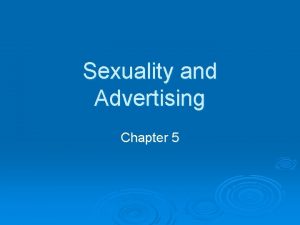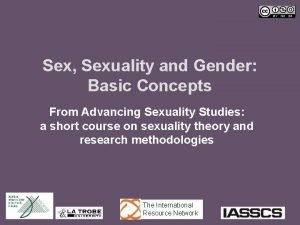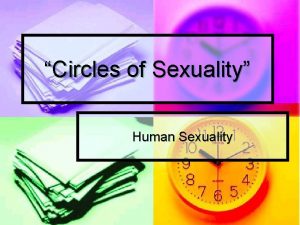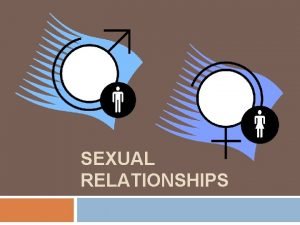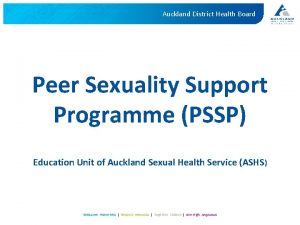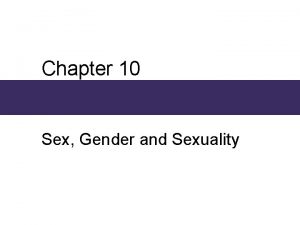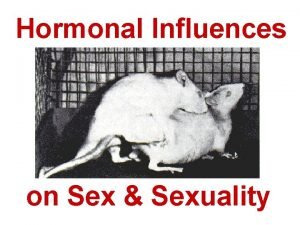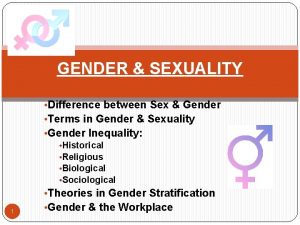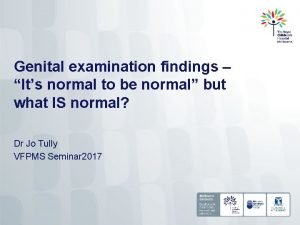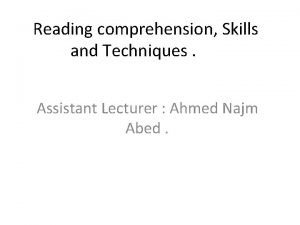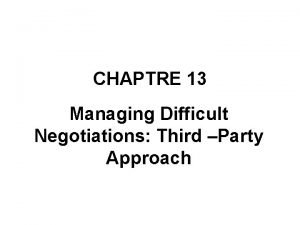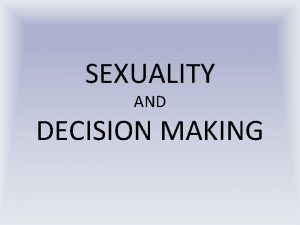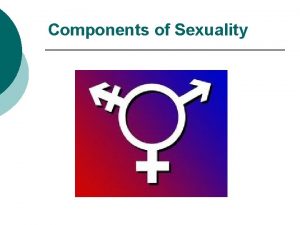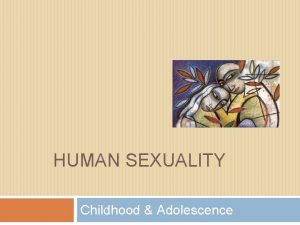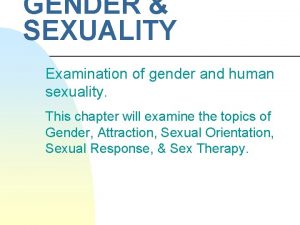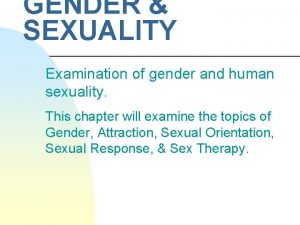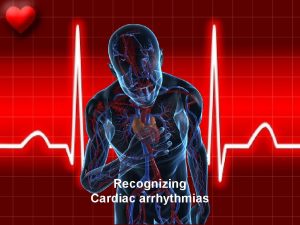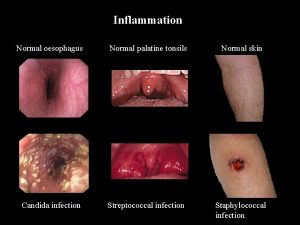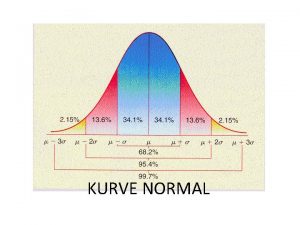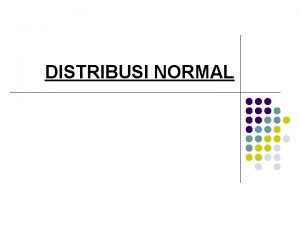Human sexuality Normal sexuality q q Difficult to































- Slides: 31

Human sexuality

Normal sexuality q q Difficult to define Easier to define abnormal sexuality

Abnormal sexuality q. Destructive q. Compulsive q. Cannot be directed to a partner q. Excludes stimulation of the primary sex organs q. Guilt feeling and anxiety

psychosexuality Sexuality and total personality are so entwined that to speak of sexuality as a separate entity is virtually impossible

Sexuality and psychosexual factors q. Sexual identity q. Gender identity q. Sexual orientation q. Sexual behavior

Sexual identity q. All mammalian embryos are anatomically female during early stages of fetal life q. Differentiation results from the action of fetal androgens q. Actions begins at the age of six and ends at age of 12 weeks of gestational age

Gender identity q. Psychological aspects of behavior related to masculinity and femininity q. By the age of 2 -3 almost everyone has a firm conviction that “I am male” or “I am female” q. Most often congruent q. May conflicting or even opposite way q. Results from experiences with family members, teachers, friends, and coworkers and from cultural phenomena

Sexual orientation Describe the object of a person’s sexual impulse q heterosexual(opposite sex) q homosexual( same sex) q bisexual(both sex)

Sexual behavior physiological response q. Desire phase q. Excitement phase q. Orgasm phase q. Resolution phase

Desire phase q. Or appetitive phase q. Reflects motivation, drives, and personality q. Characterized by sexual fantasies and the desire to have sexual activity

Excitement phase Brought on by q. Psychological stimulation( fantasy or love object) q. Physiological stimulation(stroking or kissing) q. Combination of both

Excitement phase Male physiological changes q Penile erection q Nipple erection q Increased testes size Female physiological changes q Erection of clitoris then retracts q increased breast size q Labia minor becomes thick and deep red q Orgasmic plateform (constriction along the outer third)

Orgasm phase Male q. Inevitable ejaculation q. Forceful emission of semen q 4 -5 rhythmic contraction of the prostate, seminal vesicles, vas and urethra Female q 3 -15 contraction of the lower third of vagina q. Strong sustained contraction of uterus

Orgasm phase q. Facial grimacing q. Carpopedal spasm q. Increased blood pressure 20 -40 mm hg q. Increased heart rate up to 160 q. Cloudiness of consciousness q. Lasts 3 -25 seconds

Resolution phase If orgasm occur q. Detumescence of genitalia q. Subjective sense of well-being q. General relaxation q. Muscular relaxation If orgasm not occur q. Prolonged resolution phase q. Irritability and discomfort

Sexual disorders q. Sexual desire disorder q. Sexual arousal disorder q. Orgasm disorder q. Sexual pain disorder

Hypoactive sexual desire disorder � 20% of population � > �Unconscious fear �Unresolved oedipal conflict �Vagina dentata �Chronic stress, anxiety, depression �Abstinence from sex �Hostility to a partner

Female sexual arousal disorder �Generally under stimated �Often orgasm problem as well � 33% of women in happy married couple �Anxiety, guilt, fear �Usually with dyspareunia and lack of desire �Alteration in testosterone, estrogen, prolactin thyroxine

Male erectile disorder �Punitive superego �Inability to trust �Fear, anxiety, moral prohibition � 20 -50% organic base

Male erectile disorder �Lifelong, acquired, situational �Acquired, 10 -20% of all men �Lifelong, 1% of all men under age 35 � 75% of all men over 80 �Fear of impotence in all men over 40 �Psychological cause VS organic cause Morning erection Erection without plan Erection with masturbation

Female orgasmic disorder �Inhibited orgasm, anorgasmia �Masturbation or coitus �Prevalence: 30% �Fear of impregnation �Rejection by a sex partner �Damage to the vagina �Hostility toward men �Guilt feeling �Experince frustration or symptom free Pelvic complaints, lower abdominal pain, itching, vaginal discharge, Fatigue, irritability, tension

Male orgasmic disorder �Acquired male orgasmic disorder Interpersonal difficulties Greater demand of partner Ambivalent for pregnancy Unexpressed hostility More common in OCD man

Male orgasmic disorder �Orgasmic anhedonia �Incidence of orgasm disorder �Life long orgasmic disorder Indicate severe psychopathology Rigid, puritanical Back ground Sex as sinful act Conscious or unconscious incest wishes

Premature ejaculation �More common in college educated men �Chief complaint of 35 -40% of men Treated for sexual disorder �Anxiety regarding the sex act �Unconscious fear of vagina �Negative cultural conditioning �Stressful marriage

Dyspareunia � > �Often with vaginismus �Unknown incidence �History of rape �History of childhood sexual abuse �Anxiety about the sex act � 30% of all genital area surgical procedure

Vaginismus �High educated women �High socioeconomic status �Sexual trauma (rape) �Psychosexual conflict �Strict religious upbringing �Protest in nonverbal fashion

paraphilia q. Unusual fantasies or sexual urges or behaviors q. Recurrent q. Sexually arousing q. Focus on a person’s humiliating himself or herself or a partner, on children or other nonconsenting people, or on nonhuman objects q 6 months duration q. Clinically significant distress or impairment

classification q. Exhibitionism q. Fetishism q. Frotteurism q. Pedophilia q. Sexual sadism q. Sexual masochism q. Voyeurism q. Transvestic fetishism q. Paraphilia not otherwise specified

Epidemiology q. Practiced only by small percentage of the population q. But large proportion of the population victimized due to repetitive nature of disorder q. Pedophilia is most common q. Fetishism almost always occur in men q. Peak of incidence 15 -25 q. Usually 3 -5 paraphilia in a person

Etiology q. Psychological factors failure to resolve oedipal crisis early experiences q. Biological factors abnormal hormone level, hard or soft neurological signs, chromosomal abnormalities, seizure, major mental disorder

 Sexuality in advertising
Sexuality in advertising What are the 4 strands of sexuality?
What are the 4 strands of sexuality? Pretest growth development and sexuality
Pretest growth development and sexuality It is the awareness, acceptance of comfort one's body.
It is the awareness, acceptance of comfort one's body. Definition of sexuality
Definition of sexuality Types of sexual relationships
Types of sexual relationships Which illustrates an emotional aspect of teen sexuality?
Which illustrates an emotional aspect of teen sexuality? Peer sexuality support programme
Peer sexuality support programme Chapter 10 sex gender and sexuality
Chapter 10 sex gender and sexuality Sexuality
Sexuality Sexuality spectrum
Sexuality spectrum Sex
Sex Difference between sex and gender
Difference between sex and gender It's normal to be normal
It's normal to be normal Human height normal distribution
Human height normal distribution Normal pulse rate for adults age
Normal pulse rate for adults age Normal flora synthesizes and excretes
Normal flora synthesizes and excretes Is ap seminar difficult
Is ap seminar difficult Why is software difficult to build ?
Why is software difficult to build ? Why is it more difficult
Why is it more difficult The way of the transgressor is hard meaning
The way of the transgressor is hard meaning It is easy to forget how difficult life was 50 years ago.
It is easy to forget how difficult life was 50 years ago. The james lange theory of emotion states that
The james lange theory of emotion states that Tell me all about this name that is difficult to say
Tell me all about this name that is difficult to say Paragraph reading
Paragraph reading Momentum is a measure of how difficult it is to
Momentum is a measure of how difficult it is to Crucial conversations training ppt
Crucial conversations training ppt Difficult conversations role play scenarios
Difficult conversations role play scenarios Difficult conversation preparation worksheet
Difficult conversation preparation worksheet Managing difficult negotiations
Managing difficult negotiations The most difficult persuasive task is to
The most difficult persuasive task is to How difficult can this be
How difficult can this be
